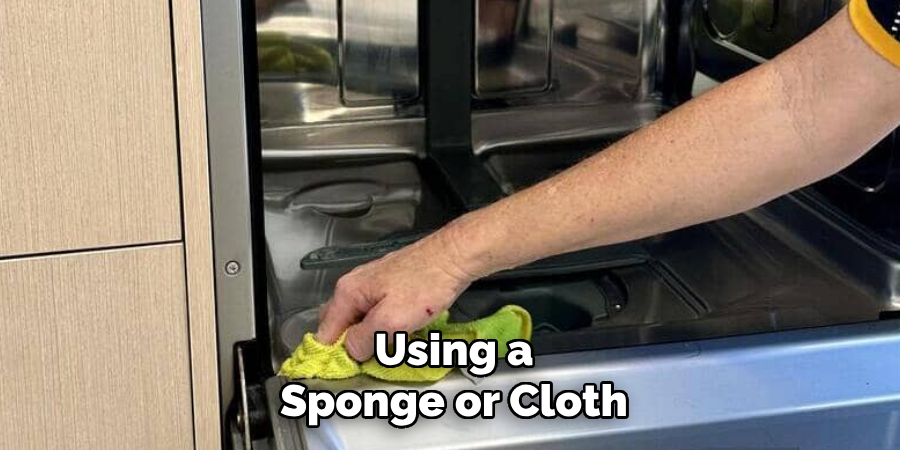Keeping your dishwasher clean is essential for maintaining its efficiency and ensuring your dishes come out sparkling clean. Over time, dishwashers can accumulate grime, limescale, and unpleasant odors due to constant exposure to food particles, grease, and hard water. One effective and natural solution to this problem is using citric acid.

This guide on how to clean dishwasher with citric acid will walk you through the steps to clean your dishwasher with citric acid, helping you extend its lifespan and keep it running like new.
Why Citric Acid?
Citric acid is a natural, environmentally friendly cleaning agent that can effectively remove limescale and mineral build-up from your dishwasher. It is also safe to use on all dishwasher components, including the filter, spray arms, and interior walls.
Moreover, citric acid is readily available at most grocery or health food stores and is affordable compared to commercial dishwasher cleaners. It also has a mild citrus scent that can leave your dishwasher smelling fresh and clean.
10 Steps on How to Clean Dishwasher With Citric Acid
Now, let’s dive into the steps for cleaning your dishwasher with citric acid:
Step 1: Gather Your Supplies
To clean your dishwasher with citric acid, you will need:
- 1 Cup of Citric Acid Powder
- Warm Water
- A Small Bowl or Measuring Cup
- A Soft-bristled Brush or Toothbrush
- A Sponge or Cloth
Step 2: Empty the Dishwasher
Before starting the cleaning process, make sure your dishwasher is completely empty. Remove all dishes, utensils, and any detachable parts like racks or the utensil holder.

This ensures that the citric acid can reach every surface inside the dishwasher and effectively break down any build-up or residue. Take a moment to inspect the interior and remove any visible debris, such as food particles, to prepare for a thorough cleaning.
Step 3: Prepare the Citric Acid Solution
In a small bowl or measuring cup, mix one cup of citric acid powder with warm water. Stir until the powder is fully dissolved to create a powerful cleaning solution.
The warm water will help activate the citric acid and enhance its cleaning properties.
Step 4: Pour the Solution Into the Dishwasher
Carefully pour the citric acid solution into the bottom of the dishwasher. Make sure it is evenly distributed to allow the solution to effectively reach all areas of the interior.
Additionally, you can use a sponge or cloth soaked in the solution to wipe down areas like the door seal and edges, which often accumulate grime. Once the solution is in place, you are ready to move on to the next step, which is to deep clean your dishwasher.
Step 5: Run a Hot Cycle
Set your dishwasher to run a hot cycle with no dishes or detergent. The high temperature and citric acid solution will work together to dissolve any build-up and kill any bacteria or germs in the dishwasher.
Also, make sure to select the “sanitize” mode if your dishwasher has one for even better results.
Step 6: Pause the Cycle
Midway through the cycle, pause the dishwasher to allow the citric acid solution to sit and soak on the interior surfaces. This soaking time helps to break down stubborn limescale deposits and grease more effectively.
Allow the solution to sit for about 20-30 minutes before resuming the cycle. During this time, you can inspect the dishwasher for any areas that might need extra attention and use a soft-bristled brush or sponge to scrub away any remaining grime if necessary. Once complete, restart the dishwasher to finish the cleaning process.
Step 7: Wipe Down the Interior
Once the dishwasher cycle is complete, open the door and allow the interior to cool slightly if it is still hot. Using a sponge or cloth, wipe down the interior walls, door, and any other surfaces to remove any loosened residue or remaining citric acid.

Pay special attention to corners, edges, and the door seal, as these areas often trap grime. Ensure you also check the spray arms and filter for any debris or build-up, giving them a gentle scrub if needed. This step helps ensure every part of your dishwasher is thoroughly cleaned and ready for use.
Step 8: Clean Detachable Parts
Remove any detachable parts, such as the racks, utensil holder, and filter, from the dishwasher. Rinse these parts under warm water to remove loose debris and residue. For tougher grime or build-up, use the leftover citric acid solution and a soft-bristled brush to scrub these components gently.
Ensure all parts are thoroughly rinsed and dried before placing them back into the dishwasher. Properly cleaning these detachable parts ensures optimal performance and prevents future dirt and grime accumulation.
Step 9: Run Another Cycle With Vinegar
For an extra deep clean and to eliminate any remaining odors, fill a dishwasher-safe bowl with white vinegar and place it on the top rack. Run another hot cycle with no dishes or detergent, allowing the vinegar to help disinfect and deodorize your dishwasher.
You can also add a few drops of lemon essential oil to the vinegar for a fresh, citrus scent.
Step 10: Maintain Regular Cleaning
To keep your dishwasher running smoothly and smelling fresh, it is essential to regularly clean it with citric acid every one to two months. This practice helps prevent build-up and maintains the efficiency and lifespan of your dishwasher.

Additionally, remember to scrape off any large food particles from dishes before loading them into the dishwasher and periodically check and clean the filter for optimal performance. These simple steps on how to clean dishwasher with citric acid will help you maintain a sparkling clean dishwasher year-round.
Additional Tips
Avoid Overloading
Overloading your dishwasher can lead to poor cleaning performance and restrict access to the cleaning solution to all areas. Always follow the manufacturer’s recommendations for loading.
Use Baking Soda
If you don’t have citric acid on hand, you can substitute it with baking soda. Mix half a cup of baking soda with warm water and proceed to follow the same steps for cleaning your dishwasher.
Regularly Clean the Door Seal
The door seal helps prevent leaks and keeps water inside the dishwasher during cycles. However, over time, grime and debris can build up in this area, leading to unpleasant odors. Regularly clean the door seal with a mixture of equal parts water and white vinegar to keep it clean and fresh.
Deep Clean Every Three Months
Every three months or so, give your dishwasher a deep clean using a mixture of hot water and white vinegar. This combination can help remove tough grime and odors, keeping your dishwasher in top condition.
Use Lemons for Fresh Scent
If you don’t have essential oils, you can use lemon slices or peels instead. Place them in the bottom of the dishwasher and run a hot cycle for an extra fresh scent.
Inspect and Clean the Spray Arms
Regularly check the spray arms for any clogs or build-up that could affect their performance. If needed, remove them and soak in warm water to dissolve any residue or use a toothpick to clear out any openings.
By regularly cleaning your dishwasher with citric acid and following these tips, you can ensure it runs efficiently and effectively, leaving your dishes sparkling clean every time. Don’t forget to also check with your dishwasher’s manufacturer for specific cleaning instructions and recommendations. Happy dishwashing!
Do You Need to Use Professionals?
While cleaning your dishwasher with citric acid is a straightforward process, there may be instances where professional assistance is beneficial. If your dishwasher has persistent issues such as severe limescale buildup, mold growth, or unpleasant odors that persist despite regular maintenance, a professional technician can diagnose and address more complex problems.

Professionals can also inspect internal components, like the motor or hoses, which are not accessible during routine cleaning, ensuring your appliance is functioning efficiently and safely. Though regular DIY cleaning can extend the life of your dishwasher, professional servicing can provide a deeper clean and tackle issues beyond your reach when necessary.
Frequently Asked Questions
Q: Can I Use Citric Acid to Clean a Stainless Steel Dishwasher?
A: Yes, citric acid is safe to use on stainless steel and other types of dishwashers. However, always check the manufacturer’s instructions and recommendations before using any cleaning product on your appliance.
Q: Can I Use Lemon Juice Instead of Citric Acid?
A: Yes, lemon juice contains citric acid and can be used as an alternative to a citric acid solution. However, it may not be as concentrated and effective as powdered citric acid. You may need to use more lemon juice to achieve similar results.
Q: Is It Safe to Mix Citric Acid with Other Cleaning Products?
A: No, it is not recommended to mix citric acid with other cleaning products, especially those containing bleach or ammonia. Combining these chemicals can create potentially harmful fumes.
Conclusion
Cleaning your dishwasher with citric acid is an easy, natural, and cost-effective way to ensure its longevity and optimal performance. By following these 10 simple steps on how to clean dishwasher with citric acid, you can effectively remove grime, limescale, and bacteria from your dishwasher’s interior for a fresh and efficient kitchen appliance.
Remember to regularly clean your dishwasher with citric acid to prevent build-up and maintain its cleanliness and functionality. Happy cleaning!
Professional Focus
Angela Ervin, a former interior designer turned blogger, specializes in kitchen design and renovations. Through her website, she blends her passion for cooking with design expertise, sharing practical and creative ideas. Known for balancing functionality and beauty, Angela’s insightful content has made her a trusted voice in home design and lifestyle.
About the Author
Angela Ervin, an experienced interior designer and blogger, combines her passion for kitchen renovations with storytelling. Living in Petersburg with her family, she enjoys cooking and testing her projects firsthand. Known for her humor and relatable style, Angela shares creative, functional design insights through her content, making her a trusted voice in home design.
Education History
University: Virginia Commonwealth University
Degree: Bachelor of Fine Arts (BFA) in Interior Design
- Angela’s education at VCU focused on mastering core interior design principles, including spatial planning, color theory, materials selection, and sustainable design practices.
- She gained hands-on experience through studio projects and collaborative design exercises, which honed her ability to create functional and aesthetically pleasing environments.
- Her coursework also emphasized problem-solving and practical applications of design, preparing her for real-world projects like her self-directed kitchen renovations.
- The program’s strong foundation in both technical skills and creative expression shaped Angela’s ability to seamlessly integrate form and function in her work.
